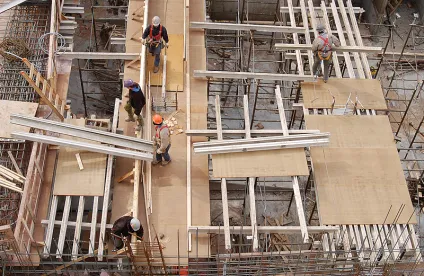There has been a recent abundance of catastrophic construction failures. One of the more recent failures occurred on March 15, 2018, when a pedestrian bridge collapsed at Florida International University killing six people. On Oct. 22, 2019, the National Transportation Safety Board issued a report blaming design errors and poor oversight for the tragedy. Two other deadly accidents occurred in the past year involving construction cranes. These examples highlight a broader concern in today’s landscape of complex construction.
Indeed, anyone beginning a construction project of any size or value has reason to be wary of the potential for delays, overruns, conflicts, defects and failures. According to a McKinsey & Co. Inc. survey, large projects across asset classes typically take 20% longer to finish than scheduled and are up to 80% over budget.
Successful construction projects can be accomplished through a variety of techniques, but the overriding theme requires effective preplanning, oversight, cooperation and anticipating problems and managing them before they become delays, failures and catastrophes. Below are 10 suggestions for planning and managing construction projects in order to bring them in on time, on budget and well constructed.
1. Careful Contracting
Aside from the construction work itself, the contract is the most important part of the project. In the case of a well-written contract, the written terms carefully and clearly define the parties' agreement, their expectations and their respective risks and obligations.
Owner-drafted contracts frequently seek to protect the owner from all possible claims. Such contracts contain exculpatory language, waivers and limitations intended to bar virtually all claims by the contractor. The idea is to protect the owner from all foreseeable and unforeseeable risks by shifting responsibility for those risks to someone else. One-sided contracts, however, may generate as many claims as they prevent.
Construction disputes are best avoided through a fair allocation of project risks. The guiding principles are that risks should be allocated first to the party who has direct control over the portion of the construction that creates the risk, and when no party has direct control, to the party who is best able to protect against an unexpected loss. When no party has any control, risk is allocated to the owner, who is the party that initiated the construction project and is the ultimate beneficiary of the results.
2. Independent Cost Estimates
Another way to ensure a successful project is to limit budget overruns by obtaining independent cost estimates as the design progresses. This involves checking and double checking the cost estimate for the work with contractors and suppliers who actually perform the type of work or supply the type of product being specified, as opposed to leaving this task to the design team.
An owner can use an outside consultant to provide objective information from trades or use its own personnel to obtain the estimates. Although this service involves an extra expense, the expense is modest and well worth the cost.
3. Establish a Firm Budget
While every project has a budget, some budgets are firmer than others. To reduce the risk of overruns, an owner should establish a firm budget and direct the architect and engineers to design to that budget. The owner should clearly establish the budget from the start and hold the designer to that budget. Also, the contracts with the designers can be written to require them to revise the plans at no cost if the bids exceed the budget by a stated percentage. Note that such a provision is difficult to negotiate with the designers, but can provide an important safeguard for the owners.
4. Use "Add and Delete" Alternatives
Under this approach, the design team preplans certain components of the work which the owner may delete if the bids come in too high, and add if the bids are lower than expected. Making sketches of alternative design concepts helps communicate and fix the project scope of work, aids in determining project feasibility, and provides more input for developing realistic estimates, budgets and schedules.
Cost estimates are prepared for each alternative to ensure selection of the best systems and components. Preplanned "add and delete" alternatives protect the owner from the delays, disruptions and extra expense caused by redesigning the project after bids are received and shifts the consideration of alternatives to the design phase when the opportunity to control costs is the greatest.
5. Peer Review the Design
An incomplete, inaccurate or poorly coordinated design inevitably will produce a project with conflicts, unanticipated costs, delays and claims. Conversely, nothing diminishes the risk of conflict, and provides protection for the owner, more than an accurate and complete design. Peer review involves an independent architect or engineer reviewing the plans in an effort to uncover errors, omissions and inconsistencies. The modest cost is justified by avoiding the delays, disruptions and extra costs which usually are involved when design errors are discovered in the field after construction is underway.
6. Review the Plans for Constructability
Constructability describes the ease and efficiency with which structures can be built. The constructability of a building depends largely on the quality of the designs — if the design documents contain errors or are difficult to interpret, the project will be more difficult to build. A constructability review is used to identify obstacles before construction.
Having a qualified contractor or project manager evaluate the plans for constructability before construction begins helps assure that the plans can be efficiently implemented in the field. Again, although this service involves an extra expense, it is a modest expense which is well worth the cost.
7. Set a Reasonable Schedule for Construction
The timeline for a construction project should be driven by the scope and needs of the project. Never start a project under undue time pressure or inevitably the project will suffer the consequences. In the event that too much time pressure is placed on the contractor, the contractor is motivated to cut corners. Cutting corners leads to poor workmanship, and poor workmanship leads to construction defects. For example, if the weather is truly worse than anticipated, or lead times on materials are affected by market conditions, it is best to willingly provide a contractor with adequate time to do the job correctly, even if doing so requires a reasonable time extension.
Also, when commencing construction, contractors justifiably expect that all necessary permits are in place, they will have access to the work, they will receive timely engineering and owner-supplied information, shop drawings will be promptly reviewed and unexpected conditions or changes will be fairly compensated. Where these expectations are not met, delays inevitably occur. To assure success, all project participants should have reasonable expectations, and know that some element of delay must be tolerated.
8. Submittals as Communication Between Contractor, Designer and Owner
A shop drawing is a drawing or set of drawings done before construction that contains all the details needed to guide the construction of the project. They take the designer’s plans and depict exactly where everything will be located. In addition, they act as a step-by-step manual of the construction process and act as a bridge between the contract documents and the contractor.
The shop drawing process seeks to avoid misunderstandings by allowing the contractor to demonstrate the detailed application of the architect’s or engineer’s design. The contractor reviews the shop drawings to coordinate the trades and verify that the project can be built. The designer reviews the shop drawings to ensure that the proposed construction scheme meets the design intent for the completed structure and the owner’s expectations. The contractor, designer and owners here share a common goal.
The process of shop drawing submittal and review is intended to be a dialogue between the designer and contractor. It is here through effective communication that the owner, contractor and designer have the best opportunity to avoid claims due to nonconforming or defective work.
9. Review Construction Activities
The prudent owner will keep a close eye on the progress of construction. Owners commonly leave construction oversight to the construction manager and often have no knowledge of conflicts which are brewing in the field. Some of those conflicts eventually become claims. Many owners find that, by the time they become aware of a claim, the dispute is far more serious (and therefore more disruptive and costly to remedy) than it would have been had the issue been detected and properly managed earlier in the construction process.
Unfortunately, some owners, even on large projects, attempt to avoid the cost of addition review. By regularly reviewing construction activities, however, an owner improves the chances of uncovering conflicts, reducing unexpected change orders, detecting potential design errors, revealing poor construction practices and avoiding claims.
One way the owner can review construction activities is by periodically reviewing project meeting minutes. Doing so improves the chances of detecting issues and conflicts before they ripen into claims. Although the construction manager is primarily responsible to oversee construction activities, occasional independent review by the owner improves the chances of recognizing conflicts early, particularly where the construction manager’s own error may have caused or contributed to a problem.
10. Periodic Audits of Contractor Billing
Construction audits provide a useful and important monitoring capacity. By using this mechanism, an owner can assess whether the project is on time, behind schedule or ahead of schedule. Periodic project audits are intended to (1) detect fraud, including contractor overbilling, inappropriate cost-shifting, abusive change order practices and other abnormalities; (2) ensure controls are in place; (3) verify contractor compliance with government requirements (e.g., prevailing wage, disadvantaged business enterprise); and (4) avoid litigation.
By regular periodic auditing, projects can be kept on track, or if off track, be used to get the project back on track. Again, the modest cost associated with the audits is money well spent.
Conclusion
The failure to incorporate these suggestions not only has a financial impact but can lead to catastrophe. Incorporating the preconstruction and construction phase planning and review concepts discussed here is the first step in avoiding terrible consequences.
The article, “10 Strategies For Planning A Successful Construction Project,” was first published in Law360 on October 25, 2019.




 />i
/>i

